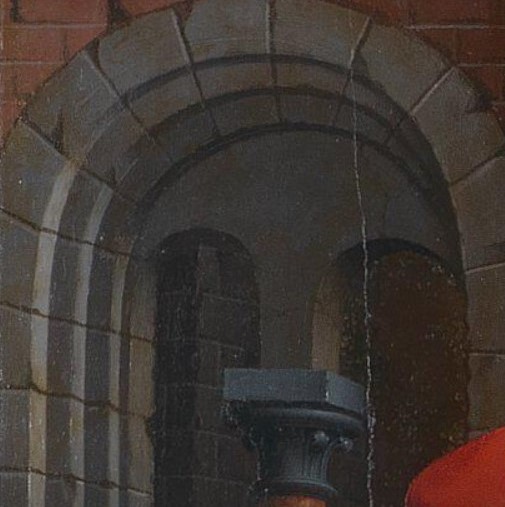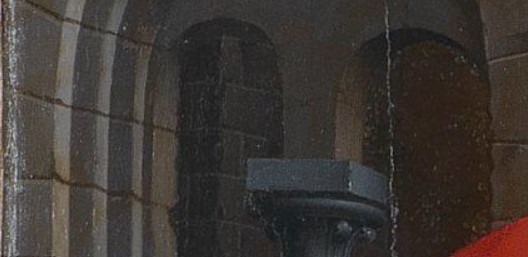Architecture as History
This is a window – but it’s not just a window, it’s a biforate window – which means that it’s a window with two openings (from the Latin bi- for ‘two’ and foratus, meaning pierced). There might be quite a few words today. For example, this biforate window uses stilted arches. The central division is made up of a column – you can just see the very top of it, a warm orangey-red, at the bottom of the detail. The shaft of this column is topped by a capital (from the Latin caput, meaning ‘head’), carved with stylised leaves (though not the acanthus of the classical Corinthian order [or ‘style’]). Above the capital is a square slab, known as the impost. Now, above the impost there is a vertical, square, cylindrical element before the arches on either side start to curve out towards the edges of the window. The point where an arch starts to curve, is the point where the arch is said to spring. A stilted arch is one which springs some distance above the impost. Effectively, it is an arch on a stilt.

All very well and good, you might say, but so what? Well, the nature of the arch can tell us the age of the building, and the types of buildings used in a painting can tell us more about where it was made – and when. In Italian Renaissance paintings the ruins (see yesterday) depicted in paintings of the Nativity tend to be ruins of classical architecture. They are saying that the birth of Jesus means that the Roman Empire is destined to fail… although they are also saying that the artists really admired classical architecture. Indeed, their contemporaries who were architects were trying to emulate, and even surpass it. Modern buildings, for the Italians, had round-topped arches, just like the ones they saw in ancient Roman ruins.
However, in the North of Europe the artists – and architects (although I should probably say ‘builders’ – precisely when ‘architects’ take over is not entirely clear) – had different interests. Buildings were still being constructed with pointed ‘Gothic’ arches way into the 16th Century. So modern buildings had pointed arches, whereas old buildings had round ones. But these were not classical buildings – they were Romanesque, with full, broad, round arches, with rounded edges, a bit like classical architecture, but after Christmas when they’ve eaten and drunk too much and could do with going on a diet and doing a bit of exercise. In the UK we might call it Norman, as it was the Normans who really introduced the Romanesque to Britain, in cathedrals such as Durham and Canterbury and Rochester and Lincoln and Winchester and Ely and Peterborough and… so on. But stilted arches are arguably Pre-Romanesque, with examples going back to the 9th century – although they do continue through to the 12th, in some cases. So the painting shows us not just an old building, but a very old building, as far as the Gothic-loving audience would have been concerned. The ruined state of it might suggest as much, but the architectural style confirms it. No wonder Jesus has come to rebuild!
However, it is clearly loved. You may be familiar with the notion of tree huggers – but how many of you have ever hugged a column? I have been known to, in moments of architectural excitement, and it’s a useful thing to do as a group if you want to work out how large some particularly impressive classical examples are. But whether the man you can see below is hugging the column because of his admiration for Pre-Romanesque architecture, or because he loves what could be Rosso di Verona – a wonderful, orangey-red stone rich in the fossils of ammonites, and transported all the way from the eponymous Italian city – so well out of the way either of Bethlehem or the original home of this painting – or, maybe, because he wants to squeeze through the biforate window to get a better view of the Christ Child, I’ll let you decide.


Really enjoying these snippets of one of my favourite paintings in the NG! Better than a chocolate a day!
LikeLiked by 1 person
So glad – though I could still do with the chocolate!
LikeLike
Well the lady of the house has got it! Remember seeing it on a recent visit there.
LikeLike
Good – it is rather well known – and rightly so!
LikeLike
Good morning Richard, Rather belatedly, I want to thank you for your blog and the fab idea of doing An Advent Calendar. I guessed yesterday the painting in question, but will not mention it here, in case this email goes straight to public comments on your blog.
I hope our paths cross one day, when we are out of this dark tunnel, I know we have both worked for MRT (in my case it was for 22 years until I cut back) and of course for WAHG.
I send my best wishes to you,
Antonia
ANTONIA WHITLEY (Dr) http://www.antoniawhitley.com
>
LikeLiked by 1 person
Thank you, Antonia – and yes, I think most people – at least those who have spent any time with it – will have recognised the painting by now! And yes, one day we will be able to meet people again. I look forward to you being one of them!
Richard
LikeLike
Just curious why the column appears to be at an angle, reminded me of the Titian, Diana and Actaeon where the reflections in the water are at the wrong angle. Are they trying to say something?
LikeLike
Interesting, but I think that must be an optical illusion, created by the angle of the beam leading away from the top of the capital. I’ve just had another look at the detail, and both sides of the column appear to me to be exactly vertical – I lined them up against the editing grid which confirmed it.
LikeLike